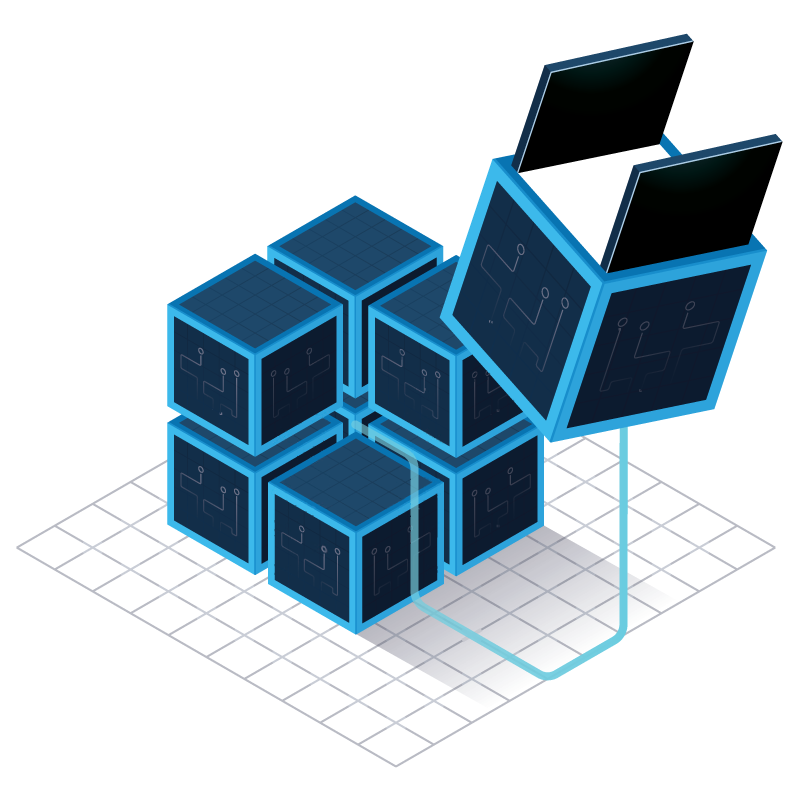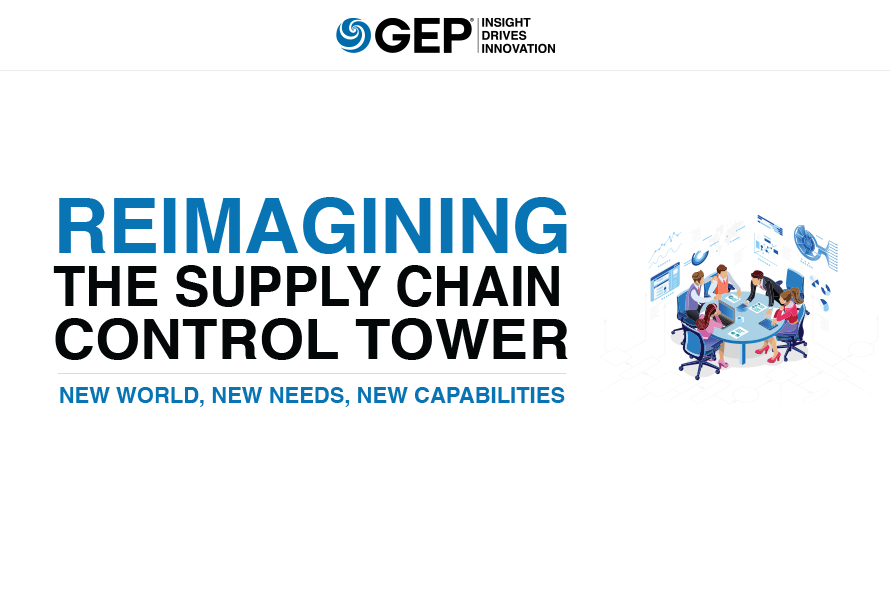Supply chain control towers have been around for a few decades. And they did serve some purpose at that time.
But not anymore.
Today’s complex, global supply chains require much greater visibility and control than what legacy control towers can offer.
A new white paper from GEP — Reimagining the Supply Chain Control Tower: New World, New Needs, New Capabilities — breaks down how supply chain control towers must evolve to help enterprises stay agile and resilient in the new normal.
What’s Inside:
- Why and how modern control towers differ from legacy solutions
- The essentials of a next-gen supply chain control tower — and why they’re important
- What best-in-class companies are doing to thrive in the new digital economy
It’s a must-read for business leaders looking for greater visibility and control over their supply chains.
INTRODUCTION
At no point in history have global supply chains faced greater challenges — or greater scrutiny — than they have in 2020. Spurred on by the ongoing U.S.-China trade war, the COVID-19 pandemic, and the continued push for greater sustainability and transparency, it’s no surprise that there is great interest in the visibility and oversight promised by supply chain control towers. But is the industry excited about them? Or are we yet to fully define terms?

As a concept, supply chain control towers have existed for almost two decades. However, the industry is yet to identify a single approach that lives up to the lofty ideals of a true supply chain control tower — one that can truly enable visibility, collaboration, analytics, and control over the end-to-end supply chain.
Traditional software applications were born out of the necessity to solve the business challenges of their times. The gap between such traditional solutions and today’s problems grows wider with rapid technological advancements and the evolution of the business ecosystem. In 2020, many global supply chains succumbed to the tremendous strain of an unpredictable and prolonged disruption. As a result, businesses are now more aware of flaws in the supply chain — and in many cases, face a completely different set of challenges than they did a year ago. Managing the supply chain based on the status quo is no longer enough. The next-generation supply chain control towers will play a different game because the game rules have changed.
OLD WORDS, A WHOLE NEW WORLD
The first supply chain control towers were created in the 2000s out of the need for process optimization, cost efficiency, and internal visibility. By the end of that decade, analysts were already talking the about the cloud revolution, and control towers were increasingly associated with the idea of a networked supply chain. Globalization had firmly taken hold by the turn of the century. As enterprises expanded their sourcing, logistics, and operations around the world, business leaders looked for a new means of connecting with their suppliers and trading partners to ensure greater visibility and collaboration over these newly expanded supply networks.
Cloud computing emerged as a promising new enabler, thanks to its scalable architecture, reliability and speed, which in turn improved visibility and business agility, resulting in faster ideation-to-market cycles and the ability to orchestrate global supply chains more efficiently. Later, as AI made inroads into the industry, control towers got smarter and brought better organizational resilience. Three words stand out here — agility, visibility, and resilience.
In today’s post-pandemic economy, the lexical recipe remains the same, and these three words still hold as much value, albeit in a different context. Here is how the game is changing:
- Visibility: The meaning of visibility has evolved. The digital revolution of the early 2000s gave business leaders better reporting and visibility into on-premise activities — how many boxes are shipped from a warehouse every day, for example. With the cloud, visibility meant global, enterprisewide internal visibility. Today, however, these capabilities are not enough, and visibility needs to extend to the ecosystem rather than being limited to the enterprise. Moreover, the granularity and scope of visibility need to change — we’re talking automated demand sensing, real-time supplier network visibility, etc. It is this visibility that brings agility and resilience to today’s supply chains
- Agility: The pandemic has redefined the meaning of business agility. In April 2020, The Wall Street Journal posited a stark image of today’s supply chains: even as warehouse shelves emptied out, elsewhere, farmers were dumping gallons of milk. Yesterday’s functional and traffic-heavy supply chains lay inactive and fragmented, and agility became synonymous with business continuity
Resilience: In retail, even top players in supply chain excellence, like Walmart and Amazon, saw a kink in their continuity curve.1 Meanwhile, automotive and manufacturing giants, like BMW, FCA, Ford and Toyota, have managed to recover only a part of their production and sales since early 2020.2, 3 Despite agile, organizationwide responses, production and logistics suffered alike, and international trade came to a halt — the pandemic left no sectors immune to disruption.4

It wouldn’t be an overstatement to say that all business operations worldwide suffered hiccups through the pandemic. Be it workforce unavailability, supplier network disruptions, or changing compliance environments, the definition of resilience is different today. Supply chain disruptions are no longer phased or isolated but concurrent. The pandemic has made clear that the focus is shifting from bringing efficiency at scale to preventing the consolidation of risk at hotspots since most businesses have been hooked to critical suppliers until now.5 How can businesses, then, bring resilience to their supply chains without compromising on efficiency?
A FAMILIAR STORY
The pandemic may have had a global effect, but even otherwise, today’s supply chains are poorly equipped to grapple with regional hazards that can severely impact continuity, thereby exposing the crux of the problem. When supply chains were maximized for efficiency, most global businesses operated without visibility beyond their enterprise (or their immediate suppliers), making them vulnerable to such black swan events. Today’s business challenges hardly coincide with yesterday’s, and businesses are failing to mitigate these challenges with control tower solutions on offer in the market.
However, where legacy solutions lack, modern ones excel. Here are three ways in which modern control towers differ from legacy solutions:
- Legacy control towers talk about a different kind of visibility. Real-time end-to-end visibility is a different game altogether. Legacy solutions are built on loose, one-sided integrations that import or export information, that only remains due for further processing. Modern control towers, on the other hand, bring real-time end-to-end visibility.
- Legacy solutions often limit their purview of supply chains to logistics and inventory management. Modern solutions encapsulate the supply chain from start to finish, rather than a few terms of the supply-demand equation.
- Legacy solutions need elaborate teams and expensive IT infrastructure and talent. While mobility restrictions and limits on workforce availability caused by the pandemic likely won’t last forever, they could have a long-term impact on how teams interact or where people work. The future of work is increasingly distributed, with fewer resources located at a single office or data center. As more solutions move to the cloud, companies will no longer rely on large, dedicated IT teams to keep hardware and on-premise software running. Modern control towers leverage automation, and artificial intelligence (AI) and machine learning (ML) technologies, and are built on the premise of no-touch operations and greater accessibility across locations and devices. AI and ML capabilities also leverage the minutiae and a bird’s-eye view of real-time data and churn them into actionable insights, which help with faster and better decision-making.
NEXT-GEN CONTROL TOWERS: COGS AND WHEELS OF THE NEW DIGITAL ECONOMY
According to an IDC survey, 88% businesses believe that supply chain resilience, or the lack thereof, will impact business in a major way. Therefore, transparency, accurate and authoritative real-time information, decision-making capabilities, and seamless, no-touch orchestration are becoming the foundations of modern supply chain control towers.
Today’s business conditions are losing constants and acquiring more variables. Data is growing faster than clock-speed, and leveraging it effectively helps companies inject greater certainty and precision into decision-making. Moreover, leveraging data enables companies to identify and mitigate risk, prevent risk consolidation, and ensure supply (and business) continuity, without impacting customers and profitability. To deal in such a dynamic ecosystem, companies need to orchestrate organizationwide responses within moments. Next-generation control towers will enable businesses to do exactly that. Here’s how:
Modern control towers are cloud-based
Supply chain data is distributed — it exists in inventories, trucks, in the enterprise, and outside the enterprise — with suppliers, suppliers of suppliers, distributors, and even in the market. However, the potential value of this data seldom exists where the data does. If a truck with your critical raw materials is delayed by three hours, what value does this information create in the hands of the truck driver or even the supplier?
Cloud enables enterprises to bring disparate data points and streams together. This not only brings visibility beyond our suppliers but also opens the door for seamless, multi-tier collaboration with suppliers and contract manufacturers. Moreover, cloud-based control towers diminish the cost of transformative disruption while keeping your business ready for aggressive scale-ups for the next wave of growth.
Unified, not just integrated
How many versions of the truth? Most enterprises today are unable to keep up with the speed at which their enterprise data grows. Each time the enterprise deploys digital solutions, like product lifecycle management (PLM) and enterprise resource planning (ERP), to solve a specific set of problems, that system creates its own data set. This scatters the data across your systems, increasing the search time for anything and everything while increasing the opacity of business functions. Many enterprises have sought to pull this data together into data lakes or data warehouses, but they still need to do the work of cleansing, analyzing, and finding insights about their supply chains.
A unified supply chain control tower must be built on resilient data architecture that leverages data from within the enterprise and beyond it. Doing this requires IoT integrations for collecting market information, weather data, transactional data along the chain, and enterprise data from legacy solutions like ERP systems. Seating a data-point within this ecosystem lends new meaning to inherently trivial information.
For example, auto OEMs in a certain region have shut down. Is it time to hunt for a different supplier, or does the problem extend beyond OEMs, to raw material suppliers? Is it simply a phased lockdown? How can your business respond to it? A modern supply chain control tower will enable enterprises to answer critical questions like these by enriching information through a unified architecture.
Driven by advanced cognitive technologies
How do data lakes enrich the tangible value of data? Cognitive technologies like AI and ML help analyze massive volumes of high-dimensional data. In the supply chain, cognitive technologies are forecasting, optimizing, and automating to new levels of accuracy and efficiency
Modern control towers leverage these technologies to bring a range of use cases and make supply chain management more nimble, smarter, and less dependent on the human touch. From demand sensing to risk assessment, logistics planning to inventory optimization, cognitive technologies are helping solve some of the most chronic supply chain challenges today.
A modern control tower should be able to spot a group of delayed shipments and analyze and explain the root cause while suggesting the next best move. Visibility will, therefore, not only expand in scope but also gain depth. While this is just one of the countless possibilities that cognitive technologies bring to the supply chain, next-generation control towers will be smarter and, therefore, more versatile in helping deal with uncertainty.
Built along these principles, supply chain control towers not only bring better agility and resilience to today’s supply chains, but also improve the stakeholders’ experience of it. Here are some ways in which new-age control towers hold relevance and bring value in today’s economy:
| FEATURES | BUSINESS BENEFITS |
|---|---|
| Demand Planning |
|
| Risk Sensing |
|
| End-to-End Visibility |
|
| Digital Collaboration |
|
| Workflow Management |
|
| Integration Capabilities |
|
| Exception Management |
|
CONCLUSION
While the need for reimagining control towers is clear, businesses must shift their focus from immediate sourcing problems to the elephant in the room. This year, 57% of companies reported longer lead times for Tier-1 components, and 75% experienced supply chain disruptions.6 Nearly half the companies experienced difficulty moving goods within China itself. Something’s severely broken. While some companies are adjusting their revenue targets downward, others are consolidating their supply chains by implementing modern control towers that bring true resilience and agility — the master ingredients of success in this quasi-static economy.
Enterprises can no longer settle for the status quo, and adjusting revenue targets downward will not help in the long run. Companies must adopt modern control tower solutions that are built to speak the language of today’s business rather than yesterday’s. Supply chains are complex, dynamic global networks — businesses need a system that can not only unify disparate data and connect parties across these networks, but that can also enable visibility and control, and bring greater confidence in decision-making. Companies immobilized by supply chain disruptions should prioritize collaborations with capable digital technology partners to not only enable business continuity, but also bring renewed agility and resilience to their business in the new normal.
- Jaewon Kang and Annie Gasparro, “Grocers Fail to Keep Up With Demand as Coronavirus Pandemic Spreads,” The Wall Street Journal, 15 March 2020. Retrieved 23 November 2020 from https://www.wsj.com/articles/grocers-fail-to-keep-up-with-demand-as-coronavirus-pandemic-spreads-11584196579
- Cipriano S. Beredo III, Karol Denniston, Christopher Giaimo and Sarah Rathke, “Impacts to Automotive Supply Chains from COVID-19,” Squire Patton Boggs’ Global Supply Chain Law Blog, 27 March 2020. Retrieved 23 November 2020 from https://www.globalsupplychainlawblog.com/automotive/impacts-to-automotive-supply-chains-from-covid-19/
- William Boston, “The Coronavirus Redraws the Car Market’s World Map,” The Wall Street Journal, 7 July 2020. Retrieved 23 November 2020 from https://www.wsj.com/articles/the-coronavirus-redraws-the-car-markets-world-map-11594141880
- Sebastian Herrera and Merrill Sherman, “Coronavirus Hobbled Amazon. How the Tech Giant Rebounded for Its Best Earnings Ever,” The Wall Street Journal, 6 August 2020. Retrieved 23 November 2020 from https://www.wsj.com/articles/coronavirus-hobbled-amazon-then-the-tech-giant-bounced-back-11596708000
- “Virus Disruption May Reshape Supply Chains,” The Wall Street Journal’s Risk & Compliance Journal, 6 April 2020. Retrieved 23 November 2020 from https://deloitte.wsj.com/riskandcompliance/2020/04/07/virus-disruption-may-reshape-supply-chains/
- “75% of Companies in ISM Virus Survey Report Supply Chain Disruptions,” Industry Week, 11 March 2020. Retrieved 23 November 2020 from https://www.industryweek.com/supply-chain/article/21125977/75-of-companies-in-ism-virus-survey-report-supply-chain-disruptions
ADDITIONAL REFERENCES
- Alex Pradhan, Tim Payne and Christian Titze, “Don’t Believe the Control Tower Hype — Buyer Beware,” Gartner, 17 August 2018. Retrieved 23 November 2020 from https://www.gartner.com/en/documents/3887267/don-t-believe-the-control-tower-hype-buyer-beware
- Alex Pradhan and Christian Titze, “Research Brief: Remove the Clouds of Confusion When Shopping for a Supply Chain Control Tower,” Gartner, 30 December 2019. Retrieved 23 November 2020 from https://www.gartner.com/en/documents/3978913/research-brief-remove-theclouds-of-confusion-when-shopp
- Chuin-Wei Yap and Jon Emont, “World Economy Shudders as Coronavirus Threatens Global Supply Chains,” The Wall Street Journal, 23 February 2020. Retrieved 23 November 2020 from https://www.wsj.com/articles/world-economy-shudders-as-coronavirus-threatens-global-supply-chains-11582474608
- Brooks Bentz, “Supply Chain Control Towers Help Organizations Respond to New Pressures,” Supply Chain Management Review, 1 July 2014. Retrieved 23 November 2020 from https://www.scmr.com/article/supply_chain_control_towers_help_organizations_respond_to_new_pressures
- Jennifer Smith, “Divided Supply Chains Are Challenging Producers, Retailers,” The Wall Street journal, 15 April 2020. Retrieved 23 November 2020 from https://www.wsj.com/articles/divided-supply-chains-are-challenging-producers-retailers-11586974088
- Jun Du, Agelos Delis, Mustapha Douch and Oleksandr Shepotylo, “Lessons From China: This Is How COVID-19 Could Affect Globalization,” World Economic Forum, 25 May 2020. Retrieved 23 November 2020 from https://www.weforum.org/agenda/2020/05/coronavirus-globalisation-shakeup-is-inevitable/
- Vijay Govindarajan and Gunjan Bagla, “As Covid-19 Disrupts Global Supply Chains, Will Companies Turn to India?” Harvard Business Review, 25 May 2020. Retrieved 23 November 2020 from https://hbr.org/2020/05/as-covid-19-disrupts-global-supply-chains-will-companies-turn-to-india

